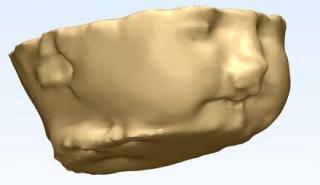Doctors at University of Michigan’s C.S. Mott Children’s Hospital have used 3D printing to determine the necessity of a lifesaving procedure for the delivery of a baby with a life-threatening mass on its face.
 A picture of the 3D printed fetal head
A picture of the 3D printed fetal head
An ultrasound test performed on Megan Thompson, the mother of baby Conan, revealed the existence of a walnut-sized lump on the face of the unborn child. This mass was a risk and could possibly block the baby’s airway after birth preventing the child from breathing
3D printing helped the doctors at the hospital to decide if a complex lifesaving 'EXIT' procedure was required. The doctors used a specialized MRI of the fetus in the womb alongside a 3D printer to print 3D models of the fetus' face. They were able to determine the the position of the soft tissue mass, and exactly how much of a danger it posed.
Based on the images we had, it was unclear whether the mass would block Conan’s airway after birth. The 3D printed model of the fetus allowed us to actually see in person what it looked like and have something in our hands to help us decide the best way to care for the baby. This is the first case we are aware of that 3D printing has helped show how severe an airway risk in a fetus was in order to make clinical decisions. 3D printing may be an incredibly valuable tool to help doctors prepare for complex cases ahead of birth.
Glenn Green, M.D
EXIT (Ex-Utero Intrapartum Treatment) procedures are a rare and complex surgical delivery procedure. They involve the partial delivery of the baby, followed by the securing of an airway at the first possible moment to ensure the baby does not suffocate. The 3D printed models provided extra information that allowed them to proceed with a scheduled C-section to deliver the baby.
I was terrified when I found out there was a possibility my baby might not be able to breathe after birth. Hearing him cry after he was born was the most incredible, emotional experience because I knew he was OK.
They told me the 3D printed models would help give them a more accurate idea of what was going on and what kind of delivery I should have. I was relieved that I didn’t need the more complicated and risky surgery and could be awake for the birth of my first baby. I’m glad that what they did for Conan may help other babies and their families in similar situations.
Megan Thompson, Mother
This is not the first time 3D printing has been used to save babies lives. Doctors at the University of Michigan have used 3D printed splints to treat and save babies suffering from severe tracheobronchomalacia. This condition prevents normal breathing by periodically causing the windpipe to collapse. Dr. Hollister and Dr. Green are leading a team to design tailored medical implants to treat tracheobronchomalacia and other conditions.